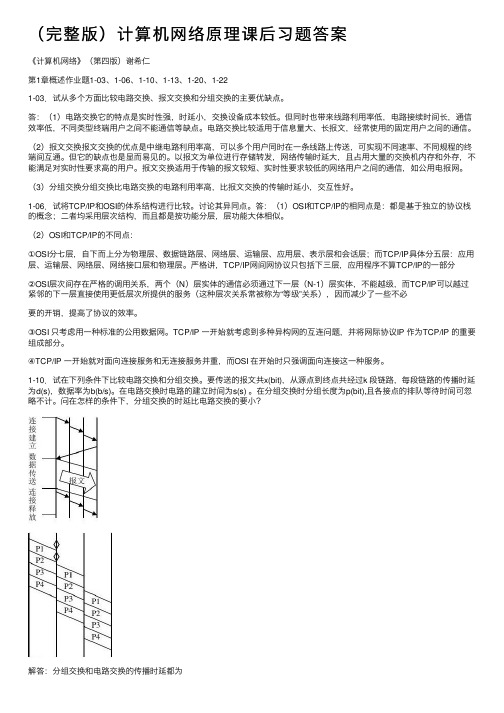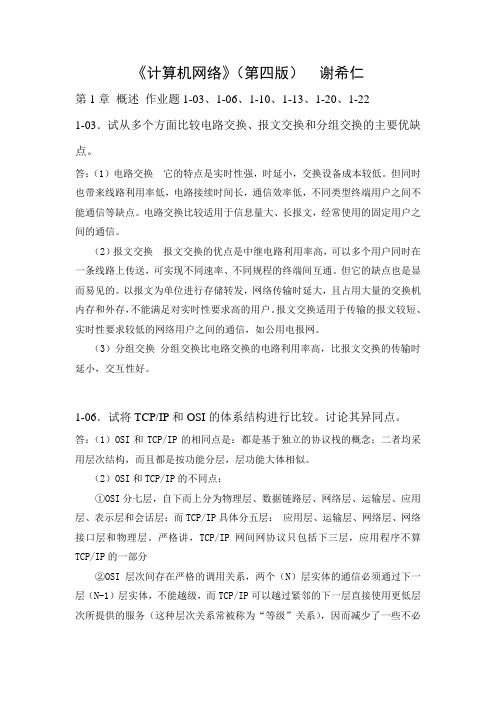计算机网络原理习题讲解
计算机网络原理课后习题答案

第1章PSE:分组交换设备 PAD:分组装配、拆卸装备NCC:网络控制中心FEP:前端处理机IMP:接口信息处理机PSTN:电话交换网ADSL:非对称用户环路DDN:数字数据网FR:帧中继ATM:异步转移模式ISDN:综合服务数字网VOD:电视点播WAN:广域网LAN:局域网MAN:城域网OSI:开放系统互连基本模型ITU:国际电信联盟IETF:英特网工程特别任务组第2章1.说明协议的基本含义,三要素的含义与关系。
答:为计算机网络中进行数据交换而建立的规则、标准或约定的集合就称为协议。
协议三要素:(1)语义:涉及用于协调与差错处理的控制信息。
(2)语法:涉及数据及控制信息的格式、编码及信号电平等。
(3)定时:涉及速度匹配和排序等。
3.计算机网络采用层次结构模型的理由是什么?有何好处?答:计算机网络系统是一个十分复杂的系统。
将一个复杂系统分解为若干个容易处理的子系统,然后“分而治之”逐个加以解决,这种结构化设计方法是工程设计中常用的手段。
分层就是系统分解的最好方法之一。
分层结构的好处在于使每一层实现一种相对独立的功能。
每一层的功能相对简单而且易于实现和维护。
具有很大的灵活性。
分层结构有利于交流、理解和标准化。
6.请比较面向连接服务和无连接服务的异同点。
答:面向连接服务和电话系统的工作模式相类似。
数据传输过程前必须经过建立连接、维护连接和释放连接的3个过程;在数据传输过程中,各分组不需要携带目的的节点的地址。
面向连接数据传输的手法数据顺序不变,传输可靠性好,需通信开始前的连接开销,协议复杂,通信效率不高。
无连接服务与邮政系统的信件投递过程相类似。
每个分组都是要携带完整的目的节点的地址,各分组在通信子网中是独立传送的。
数据传输过程不需要经过建立连接、维护连接和释放连接的3个过程;目的节点接收到的数据分组可能出现乱序、重复与丢失的现象。
可靠性不是很好,通信协议相对简单、效率较高。
9.试比较OSI/RM与TCP/IP的异同点。
计算机网络教程知识点和习题

计算机网络教程知识点和习题B类和C类地址都是单播地址,D类地址用于多播,E类地址保留为以后用。
划分子网:1个C类地址空间仅能容纳254台主机,划分子网的编址方法大大减小了对A、B类地址空间的浪费。
截图3.CIDR:无分类域间选择(CIDR)无分类编址:1.网络地址=子网掩码ANDIP地址2.同样的IP地址和不同的子网掩码可以得出相同的网络地址,但不同的子网掩码的效果是不同的,最大地址是一样的,各自容纳的最大主机数是不一样的。
3.斜线记法(CIDR记法)中,斜线后面的数字就是地址掩码中1的个数。
CIDR记法提供了IP地址,子网掩码,能分配几个IP地址,也就是地址空间大小,并能计算最大,最小地址。
看书4.ARP协议:1.IP地址放在IP数据报的首部,而物理地址则放在MAC帧的首部。
在网络层和网络层以上使用的是IP地址,而数据链路层及以下使用的是物理地址。
2.地址解析协议ARP解决知道IP地址求物理地址,逆地址解析协议RARP解决知道物理地址求IP地址的。
3.每一个主机都设有一个ARP高速缓存,里面有所在的局域网上的各主机和路由器的IP地址到硬件地址的映射表。
4.ARP是解决同一个局域网上的主机或路由器的IP地址和硬件地址的映射问题。
否则只能通过路由器了。
5.RARP协议:第六章DHCP协议中介绍6.IP首部:1.一个IP数据报由首部和数据两部分组成。
首部的前一部分是固定长度,共20字节,是所有IP数据报必须具有的。
2.片偏移是起始位数除以8,IP数据报结构,截图7.路由表:看书8.默认路由:看书9.ICMP协议的应用:1.ICMP报文作为IP层数据报的数据,加上数据报的首部,组成IP数据报发送出去。
ICMP协议是IP层的协议。
2.ICMP 差错报告报文:终点不可达,源点抑制,超时,参数问题,改变路由(重定向),ICMP询问报文:回送请求和回答,时间戳请求和回答。
10.RIP协议:1.因特网把路由选择协议划分为内部网关协议(RIP和OSPF等)和外部网关协议(BGP)。
(完整版)计算机网络原理课后习题答案

(完整版)计算机⽹络原理课后习题答案《计算机⽹络》(第四版)谢希仁第1章概述作业题1-03、1-06、1-10、1-13、1-20、1-221-03.试从多个⽅⾯⽐较电路交换、报⽂交换和分组交换的主要优缺点。
答:(1)电路交换它的特点是实时性强,时延⼩,交换设备成本较低。
但同时也带来线路利⽤率低,电路接续时间长,通信效率低,不同类型终端⽤户之间不能通信等缺点。
电路交换⽐较适⽤于信息量⼤、长报⽂,经常使⽤的固定⽤户之间的通信。
(2)报⽂交换报⽂交换的优点是中继电路利⽤率⾼,可以多个⽤户同时在⼀条线路上传送,可实现不同速率、不同规程的终端间互通。
但它的缺点也是显⽽易见的。
以报⽂为单位进⾏存储转发,⽹络传输时延⼤,且占⽤⼤量的交换机内存和外存,不能满⾜对实时性要求⾼的⽤户。
报⽂交换适⽤于传输的报⽂较短、实时性要求较低的⽹络⽤户之间的通信,如公⽤电报⽹。
(3)分组交换分组交换⽐电路交换的电路利⽤率⾼,⽐报⽂交换的传输时延⼩,交互性好。
1-06.试将TCP/IP和OSI的体系结构进⾏⽐较。
讨论其异同点。
答:(1)OSI和TCP/IP的相同点是:都是基于独⽴的协议栈的概念;⼆者均采⽤层次结构,⽽且都是按功能分层,层功能⼤体相似。
(2)OSI和TCP/IP的不同点:①OSI分七层,⾃下⽽上分为物理层、数据链路层、⽹络层、运输层、应⽤层、表⽰层和会话层;⽽TCP/IP具体分五层:应⽤层、运输层、⽹络层、⽹络接⼝层和物理层。
严格讲,TCP/IP⽹间⽹协议只包括下三层,应⽤程序不算TCP/IP的⼀部分②OSI层次间存在严格的调⽤关系,两个(N)层实体的通信必须通过下⼀层(N-1)层实体,不能越级,⽽TCP/IP可以越过紧邻的下⼀层直接使⽤更低层次所提供的服务(这种层次关系常被称为“等级”关系),因⽽减少了⼀些不必要的开销,提⾼了协议的效率。
③OSI 只考虑⽤⼀种标准的公⽤数据⽹。
TCP/IP ⼀开始就考虑到多种异构⽹的互连问题,并将⽹际协议IP 作为TCP/IP 的重要组成部分。
《计算机网络习题集》知识讲解

目录第 1 章绪论第 2 章基本概念第 3 章OSI 模型第 4 章信号第 5 章编码第 6 章数字数据传输:接口和调制解调器第7 章传输媒介第8 章复用第9 章错误检测与纠正第10 章数据链路控制第11 章数据链路协议第12 章局域网第13 章城域网第14 章交换:一个网络层功能第15 章综合业务数字网第16 章X.25第17 章帧中继第18 章ATM第19 章SONET/SDH第20 章网际互连和网络设备第21 章传输层第22 章OSI 高层第23 章TCP/IP第 1 章绪论1.3 习题一、填空题1.组建计算机网络的目的是实现信息传递和 ______________ 。
2.通常所说的“三网合一”的“三网”是指电信网、 _______________ 和计算机网二、选择题2.组建计算机网络的目的是为了能够资源共享,这里的计算机资源主要是指硬件、软件和( )A. 大型机 B •通信系统 C .服务器 D•数据3.计算机网络与分布式系统之间的主要区别是在( ) A .系统物理结构 B .系统高层软件 C .传输介质D.服务器类型4.网络协议中规定通信双方要发出什么控制信息,执行的动作和返回的应答的部分称为()A .语法部分B .语义部分C .定时关系 D.以上都不是5.网络协议的三个要素是:语法、语义与( )A . 工作原理B .时序C .进程D .传输服务三、简答题1. 计算机网络的功能有哪些?2. 计算机网络与分布式系统有什么异同点?3. 什么是网络协议?它由哪几个要素组成?1.4 习题答案一、 填空题1. 资源共享2. 有线电视网二、 选择题1. C2. D3. B4. B5. B三、简答题1. (1)数据通信( 2)资源共享( 3)提高系统处理能力( 4)分担负荷,提高效率( 5)提高可靠性 2. 共同点:一般的分布式系统是建立在计算机网络之上的, 所以分布式系统与计算机网络在物理结构上基本相同 不同点:1. 早期的计算机网络是由( )组成系统。
计算机网络原理习题讲解精编版

计算机网络原理习题讲解精编版MQS system office room 【MQS16H-TTMS2A-MQSS8Q8-MQSH16898】ChapterI1. Whatisthedifferencebetweenahostandanendsystem??2. Whatisaclientprogram?Whatisaserverprogram?Doesaserverprogramrequesta ndreceiveservicesfromaclientprogram?3. ,companyaccess,ormobileaccess.4. Dial-upmodems,HFC,,providearangeoftransmissionratesandcommentonwhetherthe transmissionrateissharedordedicated.5. .6. Whatadvantagedoesacircuit-switchednetworkhaveoverapacket-switchednetwork?WhatadvantagesdoesTDMhaveoverFDMinacircuit-switchednetwork?7. 2,000km 8102⨯prop d trans d trans d t =prop d trans d trans d prop d trans d trans d 8105.2⨯=s prop d trans d 6108⨯下列说法中,正确的是()。
A.在较小范围内布置的一定是局域网,币在较大范围内布置的一定是广域网B.城域网是连接广域网而覆盖园区的网络C.城域网是为淘汰局域网和广域网而提出的一种网络技术D.局域网是基于广播技术发展起来的网络,广域网是基于交换技术发展起来的向络 解答:D 。
通常而言,局域网的覆盖范围较小,而广域网的覆盖范围较大,但这并不绝对。
有时候在一个不大的范围内采用广域网,这取决于应用的需要和是否采用单一网络等多种因素。
计算机网络典型习题讲解

TCP删除 关闭连接 删除/关闭连接 删除
FIN=1 Seq#=M ACK=1,Ack#= M+1 ,
M=连接关闭前已经被确认收到数据的最后一个字节的序列号加 连接关闭前已经被确认收到数据的最后一个字节的序列号加1 连接关闭前已经被确认收到数据的最后一个字节的序列号加 任何一方(client or server)都能够发送关闭请求,单向关闭 都能够发送关闭请求, 任何一方 都能够发送关闭请求 单向关闭.
A到B的连接关 到 的连接关 闭
ACK=1,Ack#= (7401) ,
此时,A不能继续向 传输数据,反过来可以,因为TCP关闭连接 此时, 不能继续向B传输数据,反过来可以,因为 关闭连接 不能继续向 传输数据 具有单向性,上面只关闭了A到 的连接 的连接, 到 的连接未关闭 具有单向性,上面只关闭了 到B的连接,B到A的连接未关闭
计算机网络习题讲解
1
第一章
基本概念
端到端延迟计算
2
OSI参考模型 参考模型
请从低到高的顺序指出OSI参考模型中的七层, 并对其中(任选的)五层的 每一层指出一个实际协议的例子. 答:物理层,数据链路层,网络层,传输层,会话层(或会晤层),表示 层,应用层
物理层:任何一种调制解调体制 数据链路层:ALOHA,CSMA或CSMA/CD,TDMA,FDMA,CDMA,FDDI 等之一 网络层:ARP,IP,ICMP,OSPF,BGP等 传输层:TCP,UDP之一 会话层:NetBIOS等 表示层:XML,HTML,MIME,XDR等 应用层:FTP,HTTP,DNS,SMTP,DHCP, RIP ,ODBC,RPC等
8
解答
a."带宽时延"积=(1e7/2.5e8)*1e6=40,000bit b.40000bit c.一条链路的带宽时延积就是这条链路上具有的比特数的最大值. d.1e7/4e4=250m,比一个足球场的长度还长. e.s/R
(完整版)计算机网络原理课后习题答案

《计算机网络》(第四版)谢希仁第1章概述作业题1-03、1-06、1-10、1-13、1-20、1-221-03.试从多个方面比较电路交换、报文交换和分组交换的主要优缺点。
答:(1)电路交换它的特点是实时性强,时延小,交换设备成本较低。
但同时也带来线路利用率低,电路接续时间长,通信效率低,不同类型终端用户之间不能通信等缺点。
电路交换比较适用于信息量大、长报文,经常使用的固定用户之间的通信。
(2)报文交换报文交换的优点是中继电路利用率高,可以多个用户同时在一条线路上传送,可实现不同速率、不同规程的终端间互通。
但它的缺点也是显而易见的。
以报文为单位进行存储转发,网络传输时延大,且占用大量的交换机内存和外存,不能满足对实时性要求高的用户。
报文交换适用于传输的报文较短、实时性要求较低的网络用户之间的通信,如公用电报网。
(3)分组交换分组交换比电路交换的电路利用率高,比报文交换的传输时延小,交互性好。
1-06.试将TCP/IP和OSI的体系结构进行比较。
讨论其异同点。
答:(1)OSI和TCP/IP的相同点是:都是基于独立的协议栈的概念;二者均采用层次结构,而且都是按功能分层,层功能大体相似。
(2)OSI和TCP/IP的不同点:①OSI分七层,自下而上分为物理层、数据链路层、网络层、运输层、应用层、表示层和会话层;而TCP/IP具体分五层:应用层、运输层、网络层、网络接口层和物理层。
严格讲,TCP/IP网间网协议只包括下三层,应用程序不算TCP/IP的一部分②OSI层次间存在严格的调用关系,两个(N)层实体的通信必须通过下一层(N-1)层实体,不能越级,而TCP/IP可以越过紧邻的下一层直接使用更低层次所提供的服务(这种层次关系常被称为“等级”关系),因而减少了一些不必要的开销,提高了协议的效率。
③OSI 只考虑用一种标准的公用数据网。
TCP/IP 一开始就考虑到多种异构网的互连问题,并将网际协议IP 作为TCP/IP 的重要组成部分。
计算机网络习题和参考答案解析

计算机网络习题和参考答案解析计算机网习题及参考答案第一章1.1写出计算机网络的定义,指明涉及到的知识点。
答:计算机网络是通过传输介质、通信设施和网络通信协议,把分散在不同地点的计算机设备互联起来,实现资源共享和信息传输的系统。
涉及到的知识点:1)传输介质;2)通信协议;3)不同地点.;4)计算机设备;5)资源共享;6)数据传输;7)系统。
1.6计算机网络提供的基本功能有哪些?答:1)数据通信。
计算机网络中的计算机设备,终端与计算机、计算机与计算机之间进行通信,数据传输,实现数据和信息的传输、收集和交换。
2)资源共享。
用户通过计算机网络可以共享系统内的硬件、软件、数据、文档信息,以及通过信息交流获取更多的知识。
3)给网络用户提供最好的性价比服务,减少重复投资。
4)提供大容量网络存储,不断增加新的多媒体应用。
5)提供分布式处理,使得协同操作为可能;平衡不同地点计算机系统的负荷,降低软件设计的复杂性,充分利用计算机网络系统内的资源,使得网格计算成为可能,提高计算机网络系统的效率。
6)对地理上分散的计算机系统进行集中控制,实现对网络资源集中管理和分配。
7)提供高可靠性的系统,借助在不同信息处理位置和数据存储地点的备份,通过传输线路和信息处理设备的冗余实现高可靠性。
1.13计算机网络的协议体系结构什么特征?答:计算机网络中计算机进行通信、数据交换时需要制定算双方都要遵守的通信规则和约定就是协议。
协议是按层次节后世界的,协议层次的集合构成了协议体系结构。
网络协议层次结构包含两个基本内容:1、网络实现的功能分解到若干层次,每个功能用同等层协议或对等层协议实现,不同系统中的对等层要遵循对等层协议,通过对等层协议理解和完成该层的功能。
2、相邻层次之间通过接口交互必要的信息,构成下层为上次提供服务的关系,也成为接口关系。
网络服务靠服务原语进行描述,网络协议软件根据网络协议结构进行设计和开发。
1.19 A1.26通信1.27局域网、城域网、广域网第二章2.7写出网络协议的三个要素的主要内容。
- 1、下载文档前请自行甄别文档内容的完整性,平台不提供额外的编辑、内容补充、找答案等附加服务。
- 2、"仅部分预览"的文档,不可在线预览部分如存在完整性等问题,可反馈申请退款(可完整预览的文档不适用该条件!)。
- 3、如文档侵犯您的权益,请联系客服反馈,我们会尽快为您处理(人工客服工作时间:9:00-18:30)。
Chapter I1. What is the difference between a host and an end system? List the types of end systems. Is aWeb server an end system?2. What is a client program? What is a server program? Does a server program request andreceive services from a client program?3. List six access technologies. Classify each one as residential access, company access, ormobile access.4. Dial-up modems, HFC, and DSL are all used for residential access. For each of these accesstechnologies, provide a range of transmission rates and comment on whether the transmission rate is shared or dedicated.5. Describe the most popular wireless Internet access technologies today. Compare andcontrast them.6. What advantage does a circuit-switched network have over a packet-switched network?What advantages does TDM have over FDM in a circuit-switched network?7. Consider sending a packet from a source host to a destination host over a fixed route. List thedelay components in the end-to-end delay. Which of these delays are constant and which are variable?8. How long does it take a packet of length 2,000 bytes to propagate over a link of distance2,000 km, propagation speed 8102⨯ m/s, and transmission rate 2 Mbps? More generally, how long does it take a packet of length L to propagate over a link of distance d, propagation speed s, and transmission rate R bps? Does this delay depend on packet length? Does this delay depend on transmission rate?9. What are the five layers in the Internet protocol stack? What are the principal responsibilitiesof each of these layers?10. Which layers in the Internet protocol stack does a router process? Which layers does alink-layer switch process? Which layers does a host process?11. What is an application-layer message? A transport-layer segment? A network-layer datagram?A link-layer frame?12. This elementary problem begins to explore propagation delay and transmission delay, twocentral concepts in data networking. Consider two hosts, A and B, connected by a single link of rate R bps. Suppose that the two hosts are separated by m meters, and suppose the propagation speed along the link is s meters/sec. Host A is to send a packet of size L bits to Host B.a. Express the propagation delay, prop d , in terms of m and s.b. Determine the transmission time of the packet,trans d , in terms of L and R.c. Ignoring processing and queuing delays, obtain an expression for the end-to-end delay.d. Suppose Host A begins to transmit the packet at time t = 0. At time trans d t =,where is the last bit of the packet?e. Suppose prop d is greater than trans d . At time t = trans d ,where is the first bit of the packet?f. Suppose prop d is less than trans d . At time t = trans d , where is the first bit of the packet?g. Suppose 8105.2⨯=s , L = 100bits, and R = 28 kbps. Find the distance m so that prop d equals trans d .13. In modern packet-switched networks, the source host segments long, application-layermessages (for example, an image or a music file) into smaller packets and sends the packets into the network. The receiver then reassembles the packets back into the original message. We refer to this process as message segmentation. Figure 1.24 illustrates the end-to-end transport of a message with and without message segmentation. Consider a message that is 6108⨯ bits long that is to be sent from source to destination in Figure 1.24. Suppose each link in the figure is 2 Mbps. Ignore propagation, queuing, and processing delays.a. Consider sending the message from source to destination without message segmentation. How long does it take to move the message from the source host to the first packet switch? Keeping in mind that each switch uses store-and-forward packet switching, what is the total time to move the message from source host to destination host?b. Now suppose that the message is segmented into 4,000 packets, with each packet being 2,000 bits long. How long does it take to move the first packet from source host to the first switch? When the first packet is being sent from the first switch to the second switch, the second packet is being sent from the source host to the first switch. At what time will the second packet be fully received at the first switch?c. How long does it take to move the file from source host to destination host when message segmentation is used? Compare this result with your answer in part (a) and comment.d. Discuss the drawbacks of message segmentation.14. 下列说法中,正确的是( )。
